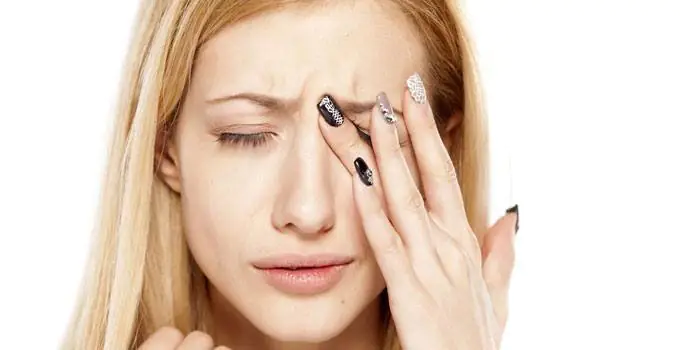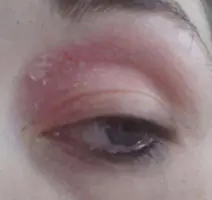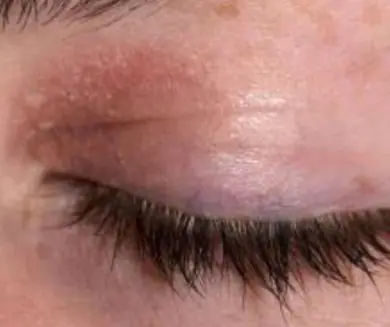When a person suddenly develops the following symptoms - itching, redness, swelling around the eyes, itchy eyelids - the causes and treatment of the disease are closely related. Many people try to diagnose themselves and are treated with old “grandmother’s” methods. and go to the ophthalmologist in a neglected state, when the itching on the eyelids reaches its apogee, and the eyelids swell so much that the person can no longer see anything. In order not to bring yourself to such a state, you need to know why your eyelids itch and what to take as first aid measures.
What is eyelid itching?
The eyelids have very sensitive skin with many nerve fibers. When these processes are constantly exposed to any stimulus, they transmit a corresponding signal to the brain, which reacts to this by excitation of motor nerve endings. This leads to the eyelids itching, redness and a desire to continuously scratch and rub the damaged area.

Itching of the eyelids is accompanied by redness of the eyeball, the skin around the eyes begins to swell from constant rubbing with the hands, the eyes water, causing inconvenience and discomfort to the patient. Some diseases are accompanied by whitish deposits on the eyelashes and their loss in advanced cases, and the formation of abscesses on the eyelids. In the first stages, the eyelids itch and peel on only one side, then the disease affects the second eyelid, which also begins to itch.
Why do my eyes itch?
The eyes are one of the most important organs of a person, with the help of which he receives incoming information, which is further processed by the brain. The appearance of an illness accompanied by a condition in which the eyelids itch raises the question: why do the eyelids itch and what to do to restore health? There are many reasons why your eyelids itch. These include:
- constant sitting in front of a computer monitor that is not protected by a special screen, in which dry eyelid syndrome occurs due to constant tension;
- eye reaction to allergic factors, which may include pollen, animal hair, new cosmetic or hygiene products, food products, medications;
- infectious processes in the body of viral or bacterial origin, conjunctivitis;
- exacerbation of chronic ailments;
- the initial stage of glaucoma or cataracts;
- reaction of the eyeballs to contact lenses and other artificial irritants.
Peeling on the eyelids
If both eyelids begin to peel and itch at the same time, dryness and irritation appear, then the cause may be an allergy. To get rid of these signs, you need to remember what new foods you ate over the last 2-3 days, what cosmetics you applied to your eyes. Perhaps this is a reaction to medications that have expired or caused such a side effect. If peeling of the eyes begins in a child, then a visit to an allergist is necessary: a series of tests will help determine what exactly the allergic reaction occurred to.

The upper eyelid is red, itchy and flaky
When a person has only one eyelid affected, while no pathological processes are noted on the other side, it is important to carefully notice developing symptoms so as not to “heal” the disease with the wrong means. If the eyelid itches, yellowish and white discharge constantly accumulates in the corner of the eye and on the eyelashes, then the following ailments may be the cause:
- conjunctivitis of any etiology;
- Graves' disease;
- demodicosis;
- herpes;
- barley;
- inflammation of the eyeball associated with penetration of infection beyond the orbital septum;
- entry of a foreign body that injures the mucous membranes, eye burn.
Lower eyelid itches
A situation where a person's lower eyelid itches and swells, accompanied by purulent discharge, can be caused by blepharitis. This common ailment, which can recur periodically, is caused by the following reasons:
- reduced immunity after suffering from colds;
- exacerbation of chronic eye diseases;
- diet poor in vitamins or microelements.
First, a person experiences slight swelling in the lower eyelid, accompanied by itching, then, if timely measures are not taken, scales form on the eyelid and lower eyelashes, leading to a decrease in the palpebral fissure due to an increase in the size of the eyelid. There is a sharp fatigue of the eyes, which are trying to function normally in such conditions, the patient simply gets tired of looking, he wants to close his eyelids all the time.
Burning
The burning sensation is not a disease, it is a symptom indicating problems in the eyes or throughout the body, so you need to try to understand the reasons why you feel pain and burning. It can be:
- pancreatic dysfunction and related diseases;
- prolonged eye strain associated with the need to constantly look intently in one direction;
- allergic processes;
- conjunctivitis;
- unsuitable lenses or glasses.

If the burning sensation is complicated by discharge from the eyes, itching, swelling, tearing, then these could be bacterial, viral or fungal infections, and this situation should not be left to chance under any circumstances. The disease is most easily treated in the initial stages, and not in advanced cases, when it is necessary to place the patient in a hospital for drug therapy and surgical intervention.
Eyelids swell
General fatigue, disruption of the daily routine, lack of sleep, and too dry air in the room cause constant swelling around the eyes. The person looks tired, with red, swollen eyelids, the palpebral fissure decreases, and it becomes difficult to look. A frosty wind blowing in the face can also be accompanied by swelling of the eyelids, however, such symptoms quickly disappear in a warm room. Insect bites can cause swelling of the eyelids until the palpebral fissures completely disappear.
Diagnostics
To eliminate the unpleasant situation when the eyelids itch, you need to correctly determine the cause that caused this condition, so ophthalmologists use the following diagnostic methods:
- assess the degree of damage to the eyelid using ophthalmological methods;
- if there is discharge from the eyes, then a swab is taken for testing for bacteriological or viral culture;
- conduct a biomicroscopic study of the eyeball;
- take samples for Demodex mites from the eyelashes of the affected eye;
- write out a referral to determine blood glucose levels to rule out diabetes;
- carry out allergic provocative tests to determine the amount of immunoglobulin E in the blood;
- find out the decrease or increase in visual acuity when using other lenses or glasses.
What to do if your eyelids itch
If problems arise with the organs of vision, when the eyelids itch outside or inside the eyes, with the feeling of a foreign object getting there, you should not panic, do not try to get rid of the discomfort with the first drops that come to hand, and even more so comb the eyelid - there is a high probability of getting it under the eyelid additional infection. If a child has problems and it is impossible to keep track of the hygiene of the inflamed eyelid, then you should immediately go to an ophthalmologist so that he can make a diagnosis and prescribe the necessary treatment.

Medical therapy
Treatment is prescribed depending on how quickly and correctly the diagnosis was made and the reason why the eyelids itch was determined. Treatment methods are as follows:
- For allergic processes, treatment consists of taking antihistamines, which eliminate the body's reaction to the allergen and the production of histamine. These can be tablets, ointments, gels, intramuscular, intravenous injections.
- Blepharitis can be treated by placing antibacterial drops in the affected eye. Additionally, the doctor prescribes NSAID-based ointments to prevent the eyelids from itching, and rinsing the eyes with diluted boric acid and other antiseptic liquids.
- Treatment of demodicosis includes taking antibiotics, to which the demodex mite is sensitive. However, there is a possibility that treatment will take a long time to achieve an effective result, since Demodex may be resistant to one or another type of antibiotic. In addition, ophthalmologists prescribe immunostimulants to boost immunity.
Folk remedies
Traditional medicine methods in situations where the eyelids itch can complement the main treatment. You should not count on the fact that with their help you can get rid of the disease once and for all. If your eyelids itch, tincture of lily of the valley will help get rid of the itching. You need to take crushed flowers and leaves of the plant in the amount of 1 tsp, pour a glass of boiling water and leave for 30 minutes, then strain. Then moisten gauze in the resulting solution and apply to closed eyes twice a day - morning and evening for half an hour.
The skin on the eyelids has become dry, swollen, itchy and flaky. Causes of the disease and how to treat itchy red spots on the eyelids.
Many people face the problem of redness and peeling of the eyelids. At the same time, they complain of severe itching, which no traditional methods can help relieve. To eliminate this pathology, they should not self-medicate, as this can cause harm to the organs of vision.
Causes of itching, redness and peeling of the eyelids
The main causes of the pathological process, against the background of which redness, swelling and peeling of the eyelids occur, include the following:
- infections,
- structural features of the eyelids,
- failure to comply with personal hygiene rules,
- entry of a foreign body under the eyelid,
- cosmetics left on the eyelids overnight,
- lack of sleep,
- wrong lifestyle
- bad habits,
- wearing contact lenses,
- temperature difference,
- reaction to changes in weather or climate,
- unhealthy diet
- frequent stress, etc.
If people are prone to allergies, as a rule, their eyelids are red, swollen, very itchy and flaky under the influence of various triggering factors.
Excess fluid in the body can cause swelling on the eyelids. Red spots and severe itching most often appear against the background of inflammatory processes developing in the organs of vision.
Severe itching and a spot on the eyelid may indicate the presence of serious pathologies, so people should immediately contact a medical facility with a highly specialized specialist. The ophthalmologist will first examine and interview the patient to understand the origin of these symptoms.
Diseases that may have similar symptoms
One of the most unpleasant diseases, against which the eyelids turn red and itch, is demodicosis. It is provoked by a small mite, which parasitizes not only the upper layer of the epidermis, but also the hair. During the acute stage of this disease, patients may experience swollen eyelids, deteriorating vision, and pathological eye fatigue. Severe itching forces people to constantly rub and scratch the skin around their eyes, which causes irritation.
The eyelids become red, itchy and flaky due to the body’s allergic reaction to various irritants, which include: animal hair, poplar fluff, household chemicals, feathers from pillows, etc. Inflammatory processes, against the background of which the eyelids begin to itch, are most often caused by the following diseases:
- conjunctivitis,
- blepharitis,
- Graves' disease
- orbital cellulite,
- chalazion, etc.
Treatment
If a person has itchy and flaky eyelids, he needs to undergo a course of treatment, which should only be prescribed by a doctor. According to statistics, in isolated cases, after visiting an ophthalmologist, patients undergo therapy in a hospital. Typically, such pathological processes are treated at home.
Patients whose eyelids begin to itch and the skin around the eyes peels are prescribed ointments, drops and gels. If the cause of discomfort is an allergic reaction, the doctor will prescribe antihistamines, in drops or tablets. At this point, it is extremely important for the patient to eliminate allergens from his environment that cause severe itching.
If a severe allergic reaction occurs, the doctor may prescribe eye drops that contain steroids.
If the eyelid itches and swells due to the development of an inflammatory process against the background of ocular herpes, conjunctivitis or infection, the doctor will prescribe ointments, anti-inflammatory and antiviral drugs to the patient. In this case, the patient will have to take a course of antibiotics with a narrow action.
Maintaining routine and personal hygiene
The first thing every person whose eyelid begins to itch should do is apply a cool compress to it or rinse the eye with water at room temperature. If this does not help, you need to seek the help of specialists.
Ophthalmologists recommend that patients complaining of spots, itching or flaking on the eyelids, first of all, observe the rules of personal hygiene. Every day, morning and evening, they should wash their face with lukewarm water. Each family member should have their own face towel, which should not be touched with dirty hands. It is recommended to wash it with laundry soap to eliminate a possible reaction to washing powders and fabric softeners.
After drying, the face towel must be ironed to destroy bacteria and microscopic demodectic mites, which are often the cause of such pathologies.
If the flaky epithelium on the eyelids is a consequence of the abuse of cosmetics, then you should immediately stop using it. Perhaps the reason lies in low-quality components that many manufacturers add to their products in order to make them more affordable. After eliminating all signs of irritation, you should not use the same cosmetic products; it is better to change the brand, giving preference to proven brands.
To ensure that your eyes are always healthy and that the skin around them does not show signs of inflammation and irritation, people should limit the time they spend watching TV and computers. It is extremely important to maintain the correct daily routine and allocate enough time for sleep.
Using traditional medicine recipes
If people experience swelling, redness and flaking around the eyes, they can use several folk recipes to combat them. You should not completely abandon traditional medicine in favor of old-fashioned methods, which are often able to relieve only the symptoms and not the causes of the pathology.
Before using traditional medicine in practice, patients need to make sure that they are not allergic to the components present in a particular drug.
To relieve redness and itching, you can use the following folk recipes.
Lily of the valley tincture
The process of its preparation is quite simple. As components you need to use not only the flowers of the plant, but also the leaves, which should be crushed and poured with boiling water (1 cup). This mixture should be left to steep for 30 minutes, after which it should be strained into a clean glass container. To eliminate itching and redness, you need to use a tincture in the form of lotions, which is recommended to be done in the evening and in the morning, until the feeling of discomfort completely disappears.
A decoction of chamomile, yarrow or calendula will help cope with irritation
To do this, add a few tablespoons of dry plant water and bring to a boil. After steeping for 20–30 minutes, the decoction is ready for use. They should wipe the skin around the eyes. You can make lotions.
Medicine made from oatmeal
To prepare this remedy, it is better to use oatmeal. Additional ingredients include milk and butter. The milk needs to be heated, and then the oatmeal is placed in it (it needs to be steamed). Add butter to the swollen oat flakes and mix all the ingredients until a homogeneous creamy consistency is obtained. Once the drug reaches room temperature, it can be applied to the affected areas of the skin. After 30 minutes, rinse off the product with water at room temperature.
This procedure can be repeated several times a day until the irritation disappears.
Aloe tincture
This product has proven itself excellent in eliminating inflammatory processes on the skin around the eyes. To prepare this potion, you need to grind a well-washed aloe leaf and place it in a glass container. Add 1 glass of boiled water, cooled to room temperature. The mixture should stand overnight, after which it can be strained and used for washing. Instead of a whole aloe leaf, you can use its juice, which is recommended to be mixed with cool water in a 1:1 ratio.
General recommendations
To prevent the development of pathological processes that can cause irritation around the eyes, people should follow the recommendations given by experts:
- maintain personal hygiene;
- get rid of the habit of touching and rubbing your eyes;
- use only high-quality cosmetics made on the basis of natural ingredients and passed Russian dermatological control;
- eliminate allergens in a timely manner;
- purchase contact lenses from trusted suppliers;
- If discomfort occurs, consult a doctor.

If the upper eyelid itches and peels, then you should not ignore this signal from the body. Most likely, it arose for a reason, and indicates certain problems with eye health.
Be that as it may, you should not self-medicate. In order not to harm yourself, you first need to establish the causes of peeling skin on the eyelids, and only then begin to act actively.
Causes of peeling eyelids
The most common factors that can be used to explain why the skin on the eyelids peels are:
- allergies or irritation of the epidermis caused by the use of low-quality or expired eye cosmetics;
- seasonal allergies;
- age factor (so-called dry eye syndrome);
- respiratory diseases;
- dry skin;
- hard or chlorinated water;
- contact lenses that were not selected in accordance with all standards, or were stored incorrectly;
- too dry air in the room, where most often there is a person who experiences redness and peeling of the upper eyelid (one or both);
- eye fatigue;
- bad habit of constantly scratching your eyes;
- prolonged sitting at a computer screen;
- using aggressive products to wash or cleanse the skin of the face.
In addition to these factors, peeling and redness of the eyelids can be the result of a foreign object getting into the eyes. In this case, the person will also experience tearing, itching and burning of the eyes. Such irritation of the mucous membrane of the visual organ cannot but affect the condition of the skin of the eyelids.

If the cause of this phenomenon is not associated with serious diseases, then peeling of the skin on the eyelids will go away on its own in a few days. However, if there is any pathology, you should consult a doctor for advice. A thorough examination and modern diagnostic methods will help determine the exact cause of the anomaly.
Pathologies that can lead to peeling of the upper eyelid are:
- Demodicosis, the development of which is caused by hair mites. It can also be diagnosed at home. So, with this disease, the patient experiences redness and flaking on the eyelids, foamy liquid is released from the eyes, and itching and burning are felt. Eyelash loss, increased lacrimation and severe redness of the whites of the eyes are possible.
- Blepharitis. Pathology often develops in people with a weak immune system, as well as with chronic conjunctivitis, vitamin deficiency, and gastrointestinal diseases. Symptoms of the disease can manifest themselves through peeling of the skin of the eyelids, heaviness in the eyes, photophobia, swelling and hyperemia of the eyelids. When the eyelids begin to peel intensely, eyelash loss occurs. There is no need to hesitate: blepharitis is a dangerous disease that can become chronic.
- Conjunctivitis is an eye disease in which there is redness of the whites of the eyes, itching and the presence of purulent discharge. The eyes become swollen and photophobia appears. If the issue of treatment is not addressed in time, the patient’s eyelid skin will begin to peel, not only the upper, but also the lower.
- Barley. This pathology can develop against the background of incompletely cured or often recurrent conjunctivitis. It manifests itself through redness of the eyes and the formation of a lump with pathological contents on the surface of the eyelid (or on its mucous membrane). If the eyelid is peeling, watery eyes and a headache appear, rest assured that your fears are correct – it’s a stye.
- Fungal infections. If the skin on the eyelids is red and peeling, especially in areas where there is hair, the cause of the abnormality may be a yeast fungus. The manifestations of the disease cannot be ignored, as it can be transmitted to others.
- Hormonal imbalance. This pathology can manifest itself in different ways. If, due to an allergy, red spots appear on the eyelids that itch and flake, then with a hormonal imbalance, only the rejection of dead cells of the epidermis is observed. This phenomenon is also not considered normal, but you should not take hormonal medications at your own discretion - leave the choice of medication to a qualified physician so as not to harm yourself.
- Herpes virus infection is another common reason why the skin on the upper eyelid peels. In this case, the epidermis becomes dry and red, and the patient develops blisters on the surface of the eyelids filled with infected fluid. They lead to itching, burning, and painful sensations.
It is extremely rare that the skin on the eyelids peels and itches, indicating the presence of:
- diabetes mellitus type 2;
- liver dysfunction;
- gastrointestinal diseases.
If you cannot independently identify the causes of dry eyelid skin and its peeling, this can only mean that some pathological processes are occurring in the body. The sooner they can be detected, the less dangerous and unpleasant the consequences for human health will be.
Useful tips for getting rid of flaking eyelid skin
To get rid of the problem, you need to carefully approach the question of what to do if the skin on your eyelids is peeling. First of all, determine the cause of this anomaly. Only after this, based on the results obtained, will it be possible to safely take certain measures.
So, general recommendations for getting rid of peeling skin of the upper eyelid are:
- Proper diet enriched with fresh fruits and vegetables.
- Avoiding stress and overwork.
- Using only high-quality decorative cosmetics.
- Purchase lenses and liquid for storing them only from trusted, licensed companies and pharmacies.
- Monitoring the cleanliness of facial skin in general.
- Avoiding eye strain.
- Avoiding contact with allergens that cause the eyelids to become red and flaky.
- Moisturizing dry eyelid skin with face creams or other cosmetics.
- Timely visit to the doctor for examination to identify various diseases. This step is especially important if all your efforts to get rid of itching and peeling of the eyelids have not been successful.
All kinds of medications are used to treat demodicosis, blepharitis, conjunctivitis or barley. In particular, this applies to eye drops and ointments.
If we are talking about herpes, due to which the skin on the eyelids becomes dry and peeling (at the last stage of the disease), then it can be cured with the help of tablets, creams or ointments (Acyclovir, Gerpevir, Zovirax, Acik, etc.).
Eye skin care and hygiene
If the skin on your eyelids is peeling, causing itching, burning, discomfort and watery eyes, you can try to relieve the condition yourself. For this purpose, decoctions of medicinal plants are used that have antiseptic, soothing, anti-inflammatory and bactericidal properties. These herbs include:
- pharmaceutical camomile;
- calendula (marigold);
- series;
- St. John's wort;
- yarrow.
Healing decoctions are prepared from these herbs, which are then used to wipe the eyelids and skin around the eyes. There is nothing complicated in preparing such tonics.
Pour 1 spoon of raw material into 200-250 ml of boiling water and leave (or simmer for 7 minutes). Cool, squeeze out the pulp, filter. Use as directed 4-5 times a day.
Ordinary black tea helps perfectly in the fight against eye diseases (conjunctivitis, barley), in which the skin on the eyelids cracks and peels. Prepare the drink and let it cool to room temperature. Soak cotton wool or applicator in tea and rinse both eyes. A clean cotton swab should be used for each eye.
This manipulation needs to be done at least 5 times a day. Tea helps remove purulent discharge from the eyes due to conjunctivitis, relieves pain and burning in the eyes.
After complete elimination of eye pathologies, the use of decoctions of medicinal plants or tea leaves should be extended for a few more days in order to prevent relapses.
In addition, cucumber water for wiping the skin of the eyelids and around the eyes, as well as tar soap for periodic washing, are good eye hygiene products. Due to their beneficial properties, among which the antiseptic effect should be noted, these components perfectly combat eye fatigue and irritation. It is especially important to use them during the period when the air is literally filled with all kinds of allergens (in mid-spring, at the beginning and end of summer).
If all of the above methods of combating peeling of the eyelid skin are ineffective, be sure to consult an ophthalmologist. Such abnormalities, especially if they occur quite often, can cause serious harm to your health. Perhaps, after undergoing a thorough diagnosis, you will need drug treatment, which can only be prescribed by a qualified specialist!



